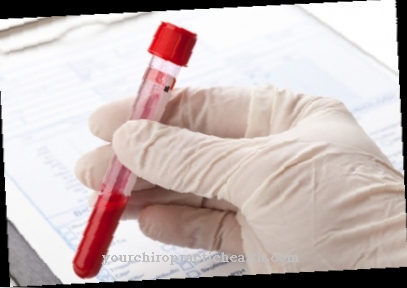In the Plasmapheresis is a therapeutic method for removing unwanted proteins, immunoglobulins or antibodies from human blood plasma. This filtering process, which takes place outside the body, can favorably influence the course of various diseases or even cure them.
What is plasmapheresis?

The term pheresis comes from the Greek and means taking away part of the whole. During the plasma exchange, which is always used for therapy, the separated portion of the plasma is discarded and replaced by another volume fluid, depending on the indication.
The majority of cases are physiological saline or Ringer's solution. The procedure is also referred to as therapeutic plasma exchange, although not the entire blood plasma is exchanged, but only undesirable, mostly protein-containing components are filtered out.
Although the plasma separation can also trigger negative side effects, these are generally accepted as the benefit for the individual patient is much greater. In English usage, plasmapheresis is also known as plasma exchange, PE. It is an established medical procedure that is subject to high scientific standards and has been further optimized and refined in recent years in order to be able to do justice to the various indications as precisely as possible. The proven therapy method can be carried out successfully under outpatient, semi-outpatient or also inpatient conditions.
Function, effect & goals
The therapeutic plasma exchange serves first and foremost to remove undesirable components in the liquid components of the flowing blood. The cellular components of the blood, i.e. all blood cells such as erythrocytes, leukocytes or platelets, are not changed during plasmapheresis.
It is all about a therapeutic influence on the composition of the blood plasma. When it comes to the effective removal of undesired antibodies as high molecular weight proteins, plasma separation is particularly useful in neurology or nephrology. If the procedure is used specifically for lipid metabolism disorders, doctors also speak of lipid apheresis. The filtration process can then be adjusted so that only undesirable microscopic fat cells, lipids, are removed from the blood plasma.
The plasma exchange is therefore a selective process in which only the undesired plasma components are to be removed. Of course, this is not always possible under all circumstances, because it can also lead to the removal of components in the plasma that should not actually be removed. Precisely because of this, certain risks and dangers for the patient can lie. Similar to hemodialysis, plasmapheresis is also a so-called detoxication process. The body should therefore be freed or detoxified by those substances that would otherwise accumulate in the plasma, that is, would accumulate.
How often and at what time intervals a therapeutic plasma separation has to be carried out is strictly dependent on the respective indication and the clinical picture. According to medical and scientific criteria, there are certain, suspected and questionable treatment indications for carrying out the procedure. What is certain is that plasmapheresis in so-called hemolytic-uremic syndrome and thrombotic thrombocytopenic purpura is very helpful for the patient in regaining or maintaining his quality of life.
Suspected indications that justify the implementation of a therapeutic plasma exchange are certain kidney diseases, so-called glomerulopathies and systemic lupus erythematosus. Both chronic diseases are so-called autoimmune diseases, and uncontrolled antibodies are formed against the body's own tissue structures. By means of plasmapheresis, these tissue-damaging antibodies can be temporarily removed from the patient's. Questionable indications are pemphigus vulgaris, a skin disease that is associated with the formation of harmful autoantibodies, and multiple sclerosis.
A therapeutic plasma exchange in multiple sclerosis can be worthwhile for the patient, especially in the case of an acute episode with disease value and worsening prognosis. However, by no means all patients who suffer from this chronic inflammatory disease of the central nervous system benefit from it.
You can find your medication here
➔ Medicines to strengthen the defense and immune systemRisks, side effects & dangers
So-called cell separators are required to perform the therapeutic separation of blood components. This process takes place outside of the body in specially developed machines. Modern cell separators all have computer-controlled valves and roller pumps.
An absolutely sterile working method is essential, because in all blood exchange procedures the greatest risk for the patient is posed by possible infections. In plasmapheresis in particular, in addition to undesired low-molecular components such as autoantibodies or pathological proteins, vital components such as clotting factors are removed from the plasma. The coagulation factors are produced in the liver and cannot be reproduced as quickly as they are removed by the plasma separation.
In many cases it is therefore necessary to add artificial coagulation factors to the cleaned plasma so that the blood's ability to clot is not impaired. A permanent bleeding tendency of the patient through therapeutic plasma exchange must be prevented. In order to be able to filter out only certain fractions of individual proteins during the process, special semi-permeable membrane plasma separators are required.
In vitro membrane tests can be used to determine precisely which sizes of molecules can pass through the membrane and which are retained before use on the patient. With plasmapheresis, both the blood sample and the return transfusion take place via the same venous access, for example in a vein in the arm. With each return transfusion, reinfusion, the patient is given back not only the purified plasma but also the cellular components, i.e. the different blood cells.












.jpg)



.jpg)










.jpg)
